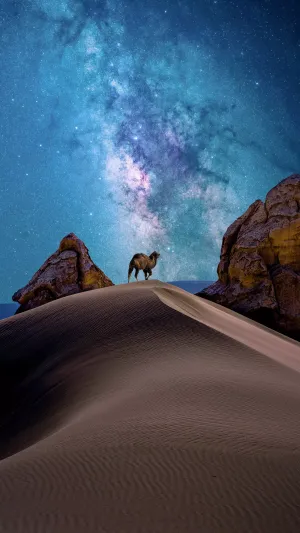The Gobi Desert, a unique expanse characterized by a blend of desert and mountainous terrain, is an intriguing landscape shaped by the forces of climate change.
Composed of gravel and clay, with rocky mountains interspersed, the Gobi has earned its name, which translates to "barren beach" – a vast, inhospitable wilderness sculpted by the ebb and flow of time.
Situated deep inland, far from the sea, the Gobi experiences arid conditions, minimal rainfall, sparse vegetation, and significant temperature fluctuations between day and night. Its defining features include relentless winds, often swift and forceful, and a scarcity of moisture. The Gobi is not just a desert; it is a harsh environment where nature exhibits its resilience and tenacity against formidable odds.
The desert's uneven terrain, covered by extensive gravel expanses, is a testament to the transformative power of strong winds. Under the influence of these winds, fine-grained sand and dust are swept away, leaving behind coarse gravel that blankets the surface, crafting the distinctive Gobi Desert.
Unlike some sandy deserts, the Gobi boasts a unique characteristic – the "narrow pipe effect" observed in certain confined areas. Here, when airflow enters canyons from open spaces, its velocity dramatically increases, resulting in powerful gusts of wind. The surface, laden with fine sand, constantly undergoes self-alteration as the wind shapes and molds the dunes into an array of different forms.
What distinguishes the Gobi further is its composition; it is made up of loess and slightly larger sandstone in a roughly equal ratio. Vegetation is sporadically scattered across the Gobi, and when the wind sweeps across its surface, it lifts sand and dust into the air, creating captivating landscapes of flying sand and rocks. Despite the harsh conditions, the Gobi's landform remains relatively stable compared to other deserts.
In this seemingly desolate environment, scattered oases emerge as life-sustaining havens, supporting the fragile ecosystem of the Gobi Desert. These oases, enriched by surface water, become vital focal points for vegetation and subsequently attract a variety of animals in search of sustenance and water.
While the surface may convey desolation, the Gobi conceals a wealth of hidden treasures beneath its barren exterior. Rich mineral resources lie beneath the ground, turning the Gobi into a trove of geological wealth. Additionally, the Gobi has proven to be a treasure trove for paleontologists. In 1923, an expedition team from the American Museum of Natural History serendipitously stumbled upon dinosaur egg fossils while searching for evidence of early human activities on the Mongolian Plateau. This discovery marked the world's first encounter with dinosaur egg fossils, and subsequent explorations in the Gobi continued to yield a plethora of dinosaur eggs and skeletal fossils.
Moreover, the Gobi Desert is renowned for its collection of unique stones which are known as wind-edge stones. The relentless day and night winds carry sand and stones across the surface, unimpeded by vegetation. Consequently, the abrasive impact of these elements wears down weak rock blocks, creating distinctive micro-topography featuring stones with one, two, or three edges.
In the Gobi Desert, the dichotomy of desolation and hidden riches unfolds, offering a testament to the resilience of life in the face of harsh environmental conditions. As we delve into its mysteries, the Gobi reveals itself as not just a desert but a dynamic landscape, shaped by wind and time, concealing tales of ancient life and geological wonders beneath its surface.





